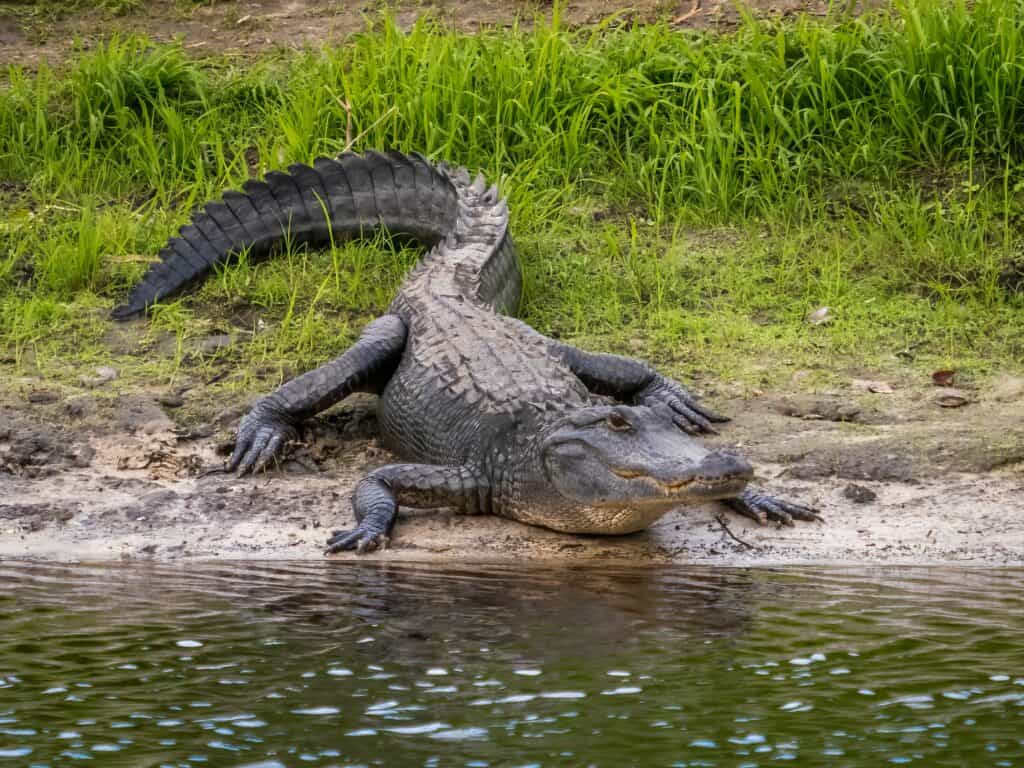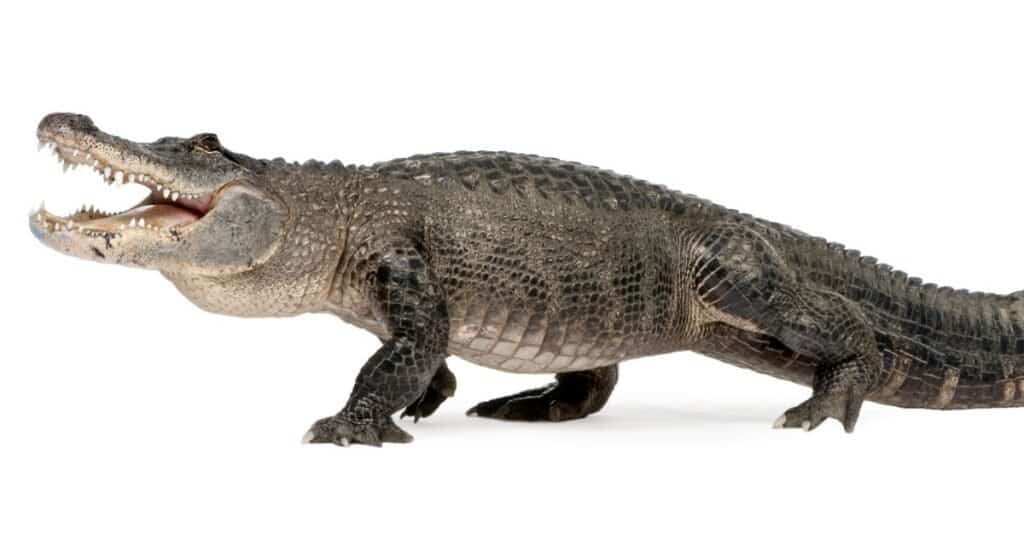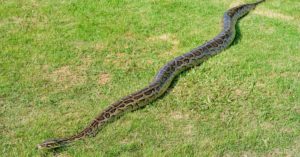Lake Worth lies along the outskirts of Fort Worth in northeast Texas. It might surprise you, but alligators live in Lake Worth, as well as fish and amphibians. Alligators are some of the largest, fiercest reptiles in North America, along with crocodiles and Burmese pythons. They’re native to the freshwater lakes, ponds, and rivers of the American South, and can be found everywhere from Florida to North Carolina to Texas. Alligators certainly aren’t as common in Texas as they are in Florida, but if you live around alligators in the lone star state, it’s still important to understand them.
Here, we’ll discover exactly how to tell whether the creature you’re looking at is an alligator. Then, we’ll learn about alligator diet and behavior. We’ll take a closer look at how many alligators are in Lake Worth and what you need to do to stay safe around them. We’ll also discover a few other north Texas lakes that gators call home.
Read on to learn more about alligators in Lake Worth, Texas!

American alligators (Alligator mississippiensis) are native to North America.
©iStock.com/Cindy Larson
Species Profile: The Alligator
It’s true: there are alligators in Lake Worth. Like most of the south’s freshwater, Lake Worth is the perfect home for gators. These reptilians are apex predators who have no natural predators as adults. They spend most of their time in the water, coming to land to lay eggs, bask in the sun, and find new water sources. They’re incredibly dangerous, so it’s important to understand them and know how to stay safe when alligators are around.
What Do Alligators Look Like?
Alligators are large, scaled reptiles that look like very heavy lizards. They’re typically dark green on their sides and backs, and light yellow on their bellies. They have short legs that end in claws and large, powerful tails. One of their most distinctive features is their head, which is large, blunt, and heavy. Alligators have large, conical teeth designed to grab and hold onto the slipperiest of prey. Their tails don’t just help them swim, they also give them the push they need to ‘death roll’ large prey.
How Big Do Alligators Get?

While gators aren’t quite as big as Nile crocodiles or saltwater crocodiles, they’re still bigger than caimans and gharials.
©Thierry Eidenweil/Shutterstock.com
An alligator is considered large if it measures more than nine feet long. The largest alligators grow up to 15 feet long and can weigh over 1,000 pounds. Most don’t get that big; however, they top out around 10-12 feet.
What Do Alligators Eat?
Baby alligators in Lake Worth and elsewhere have a high mortality rate. They start out less than a foot long, so they’re easy prey for predatory birds, fish, snakes, and bigger gators. However, they do eat insects, worms, snails, small fish, small mammals, frogs, toads, and even birds. The bigger they get, the bigger the food they can eat. Adult alligators eat large fish, turtles, snakes, smaller gators, deer, wild pigs, and anything else that wanders too close to the water.
Where Do Alligators Live?

Alligators are semi-aquatic carnivores that do most of their hunting from the water.
©Jim Schwabel/Shutterstock.com
Alligators live only in freshwater, not saltwater. They prefer shallow bodies of water with plenty of aquatic vegetation and trees, shrubs, and branches that hang over the water’s surface. But, they may be found in any body of water, from a tiny pond to a vast lake. Alligators are native to the southeastern quarter of the United States. They live in Texas, Louisiana, Mississippi, Alabama, Georgia, South Carolina, North Carolina, and Florida. They’re also found in limited areas of southern Oklahoma and Arkansas.
How Many Alligators are in Lake Worth, Texas?
Lake Worth is a part of the Trinity River watershed. Its average depth is only six feet deep, and it covers nearly 3,500 acres. According to the city of Fort Worth, there are an estimated 15-25 alligators in Lake Worth. That may seem like a lot, but in comparison to Lake Okeechobee in Florida, it’s nothing. Lake Okeechobee is home to nearly 30,000 alligators as of the last count. Alligators are native to east Texas and may be found in many sources of fresh water, including lakes, ponds, rivers, and drainage canals.
Which Other North Texas Lakes Have Alligators?
Alligators in Lake Worth aren’t the only gators roaming north Texas. Other north Texas lakes that also have alligators include Lewisville Lake, Eagle Mountain Lake, Lake Tawakoni, Grapevine Lake, Caddo Lake, and more. No matter where they are, remember that alligators are wild animals and should be treated with respect and caution.
What Other Animals Live In or Near Lake Worth, Texas?
Since it is a lake, the first consideration about animals is the fish in the lake. At Lake Worth, fishers can find catfish; largemouth, spotted, and white bass; and white crappie.
Nearby, the Fort Worth Nature Center has created a home for wildlife on several thousand acres of natural, north Texas habitat. The variety of species is amazing and includes: black-tailed prairie dogs, bison, sparrows, Northern harriers, Prothonotary warblers, Indigo bunting, Painted bunting, Mississippi Kite, Halloween Pennant dragonflies, Eastern pondhawks, herons, egrets, other waterfowl, Red-eyed vireo, Yellow-billed cuckoo, Pleated woodpecker, kinglets, White-spotted towhee, Brown thrasher, Texas whiptail lizards, Texas spiny lizards, and Scissor-tail flycatchers. The presence of birds depends on the season since some are migratory and spend only the winter or only the summer in North Texas
Are Alligators Dangerous?
Though there are no reports of alligators attacking people in Lake Worth, a few people die yearly in the United States from alligator attacks. Most of these attacks occur in Florida, Georgia, and South Carolina, but gators everywhere are considered dangerous animals. Small alligators, under four feet long, are not likely to kill a human, though they can do damage. Alligators over nine feet are, however, more than capable of killing, or seriously injuring a human.
Staying Safe Around Alligators

Alligators may seem sluggish, but they’re incredibly fast ambush hunters and can even run for short distances.
©iStock.com/GlobalP
Alligator safety, particularly regarding alligators in Lake Worth, revolves around understanding that alligators are dangerous predators. If you’re in an area that has alligators, stay at least ten feet back from any source of water. Don’t let children or pets play in or near the water. Also, never feed alligators and never try to approach, harass, or pet them.
Where is Lake Worth Located on a Map?
Lake Worth is a city in Tarrant County, Texas. It is named after a nearby popular recreational lake. The city boasts just under 5,000 people as of 2010. Many families and retirees live in this city, which has a rural feel.
The photo featured at the top of this post is © iStock.com/CoinUp
Thank you for reading! Have some feedback for us? Contact the AZ Animals editorial team.







